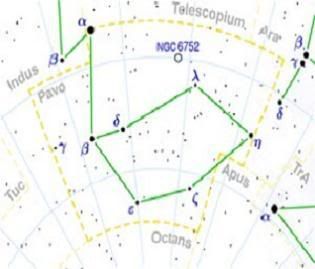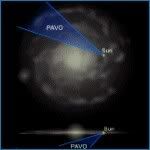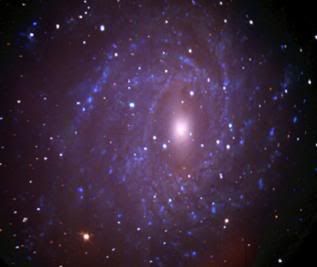Post by glactus on Feb 17, 2008 6:49:08 GMT


During the late 1590's, two Dutch navigators, Pieter Keyser and Frederick de Houtman, mapped several new constellations as they travelled South, the majority being named after recently identified birds and animals. A few years later Johann Bayer, the German astronomer, included these new star patterns in his Uranometria, published in 1603. Pavo was born.
Lying on the fringes of the Milky Way, Pavo, the peathingy, is lacking in bright objects apart from its primary star. The region of space described by Pavo is largely "beneath" the galactic disc, but it does contain a number of galaxies and globular clusters.
Notable stars:
Alpha Parvonis
This is a spectroscopic birany star. It is also known by the name Peathingy, but this is not a classical name. It was assigned to the star by Her Majesty's Nautical Almanac Office in the late 1930s during the creation of The Air Almanac, a navigational almanac for the Royal Air Force. Magnitude is 1.94 and distance from Earth is 183 light years.
Beta Parvonis
A massive white star in this constellation. It is of the type classified as one of the A-type, or Helium Stars. Magnitude is 3.42 and distance from Earth is 137 light years.
Gamma pavonis
( y Pavonis) is considered a metal-poor star, which means it has a low abundance of elements heavier than helium. It is also oribiting through the Milky Way at an unusually high velocity relative to nearby stars. Although it appears to have a lower mass than our Sun, it is slightly larger in diameter and has a higher temperature. Magnitude is 4.21 and distance from Earth is 30.1 light years.
Delta
Delta Pavonis is slightly brighter than the Sun even though it is cooler. It is a yellow-orange main sequence dwarf of spectral and luminosity type G5-8 V-IV. This star has about 1.1 times Sol's mass. Magnitude is 3.56 and distance from Earth is 19.9 light years
Notable objects:

NGC 6744
NGC 6744 is a very large and fairly bright barred spiral galaxy. The galaxy is found three degrees SE of lambda Pavonis. Distance from Earth is 25 million light years and magnitude is 9.1

NGC 6872
NGC 6872 is a relatively nearby galaxy, residing about 183 million light-years from Earth. Magnitude is 12.7.

NGC 6752
NGC 6752 is a splendid globular cluster, large and bright and compact. It's about ten degrees WSW of alpha Pav (omega Pav is just west to the west). It might be easier to find it four degrees north of NGC 7644. This cluster is considered one of the closest globulars, at about 20,000 light years away. Magnitude is 5.4.

grand vision
credits:
Image: Pavo map: wikipedia
en.wikipedia.org/wiki/Pavo_(constellation)
image: Pavo sun map: Wingmakers
home.xtra.co.nz/hosts/Wingmakers/Pavo.html
image: NGC 6752: Staff.science
staff.science.uva.nl/~alessiag/Images/ngc6752.jpg
image: NGC 6744: space.gov
www.space.gov.za/pics/ngc6744UBI.jpg
image: NGC 6872: de/gallery
www.ngc1365.de/gallery/ngc6872.jpg


